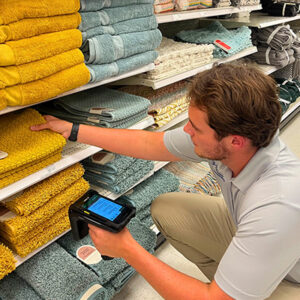
Businesses are constantly seeking ways to optimize their supply chain and inventory processes. Traditional inventory management processes often lead to inefficiencies and inaccuracies that can hurt overall business performance. Traditional inventory methods need help to keep up with the demands of modern, fast-moving industries.
This is where utilizing advanced technologies like RFID for inventory management, come into play. Utilizing RFID technology allows businesses to track and manage inventory with unmatched precision. This improves their ability to adapt to market changes, cut operational costs, and enhance customer experiences.
As consumer expectations rise and trading partners demand more transparency, RFID is quickly becoming a valuable tool for businesses looking to maintain competitiveness in the market.
How RFID Inventory Management Works
RFID inventory management uses radio frequency identification technology to optimize the tracking and management of inventory across various stages of the supply chain.
Traditional barcode systems usually require line-of-sight scanning while RFID tags automatically transmit data through radio waves. These RFID tags can be attached to individual products, pallets, or cartons. When these items pass through an RFID reader, the data stored in the tags is captured and processed in real time.
RFID technology provides faster, more accurate, and transparent tracking. It does so from when a product enters the supply chain until it reaches the end customer. This automation reduces the chances of human error, enhances visibility into inventory levels, and supports efficient stock management. With the help of RFID, companies can also better manage supply chains involving multiple locations and trading partners.
Benefits of RFID Inventory Management
There are several benefits to using RFID for inventory management that make it a valuable tool across industries. Utilizing RFID allows businesses to significantly improve operational efficiency, increase accuracy, and gain real time insights into inventory movements.
Real Time Visibility
One of the greatest advantages of RFID inventory management is real time visibility. Automatically transmitting data, RFID systems provide real-time information about inventory levels and product locations. This guarantees up-to-date inventory accuracy and efficient tracking.
This real time data can be used to monitor stock levels more accurately, avoid stockouts, and reduce shrinkage. Having this level of visibility is particularly important for businesses using omnichannel fulfillment strategies. Whether products are being shipped to stores or directly to consumers, RFID helps keep track of inventory in every channel for smooth order fulfillment.
Improved Information Accuracy
RFID technology eliminates the need for manual scanning. This means that inventory data is captured with greater precision and accuracy. Because RFID tags don’t require line-of-sight scanning, multiple items can be tracked simultaneously. This speeds up processes and reduces the chances of errors.
While the industry average for inventory accuracy with barcode scanning or manual counting is only 65%, RFID technology can achieve up to 99% accuracy, while also enabling new use cases such as traceability, authentication, security, and inbound/outbound logistics verification.
This improved accuracy helps prevent carton and shipment inaccuracies, reducing disputes between trading partners and minimizing the cost of charge-backs or returns. For example, with RFID tags, companies can make sure that the correct products are packed, shipped, and received.
Operational Efficiency
RFID inventory management systems can optimize various operational tasks. Warehouse staff can quickly locate products, identify when restocking is needed, and make sure that the right items are dispatched to the correct locations.
The speed and accuracy of RFID systems reduce the time spent on manual inventory checks and help simplify the entire inventory process. This efficiency not only saves time but also reduces labor costs. This enables businesses to focus on other value-added activities.
Common Uses of RFID in Inventory Management

RFID technology has applications in a variety of industries, from retail to pharmaceuticals and automotive. RFID labels and RFID tags are useful for tracking hard-to-tag items or products with high movement rates.
For instance, RFID helps businesses in retail manage large inventories across multiple stores and warehouses. Products like clothing, electronics, and food items can be tagged with RFID. They support businesses in monitoring stock levels and reducing the risk of shrinkage.
In the automotive industry, RFID tags can be used to track large items like tires and vehicle parts. Tagging these components allows manufacturers and suppliers to accurately identify and trace products throughout the supply chain. This improves tracking, provides precision, reduces the risk of shipment errors and makes it easier to manage stock across different locations.
Pharmaceutical companies also benefit from RFID inventory management. Tagging medications and medical supplies allows companies to maintain visibility over inventory levels. This makes certain products are available when needed while preventing overstocking or waste.
RFID Technology Advancements
The cost and size of RFID tags and readers have significantly decreased in recent years. Technology is even more accessible to businesses of all sizes. Early concerns about the high cost of RFID systems have been addressed through technological advancements.
The ability to track thousands of items simultaneously and the increased read rates of RFID readers have made the technology more efficient and effective for inventory management. In fact, some RFID readers can process up to 1,200 tags per second. They are ideal for high-volume operations.
Furthermore, RFID tags have become more versatile, with options now available for use with liquids, metals, and other traditionally hard-to-tag materials. This opens the door for other industries, where complex or difficult-to-tag items can now be tracked efficiently using RFID.
RFID Inventory Management: A Long-Term Investment
While setting up an RFID inventory management system requires an initial investment in hardware, software, and employee training, the long-term benefits often outweigh these costs. RFID technology not only improves the accuracy and speed of inventory processes. It also offers measurable returns on investment by reducing shrinkage, optimizing stock levels, and enhancing supply chain efficiency.
For companies looking to gain a competitive edge, RFID inventory management provides an opportunity to modernize operations and stay ahead of industry trends. Adopting RFID allows businesses to meet the growing demands of consumers and major retailers while also reducing operational costs. This enhances efficiency and accuracy.
At FineLine, we specialize in providing high-quality RFID products that help businesses improve inventory management and streamline their supply chains. From RFID tags to RFID labels, our products meet the needs of various industries and provide accurate item identification from start to finish.
With our proprietary FASTtrak platform, we offer a 48-hour turnaround time so we can assist you in meeting tight deadlines and maintaining operational efficiency. Whether you’re a retailer, manufacturer, or distributor, RFID inventory management can transform how you track and manage products throughout your supply chain.
If you’re ready to improve your inventory processes with RFID technology, contact us today to learn how we can help.